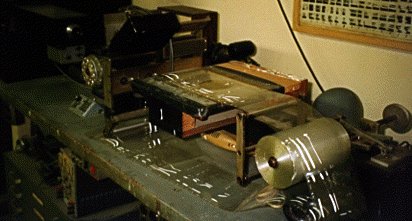Legacy: Pattern Playback: Operating Principles
A light source (a powerful mercury arc lamp, shown at the extreme left) provides an intense thin line of light which is focused radially on a rotating disc. This “tone wheel” is a film negative which has 50 circular, concentric variable-density sound tracks. These yield pure tones at 120 hertz (Hz) intervals from 120 to 6000 Hz when the tone wheel is rotated at 1800 rpm by a synchronous motor. Light is modulated by the tone wheel and directed onto the spectrogram in such a way that the spectrographic pattern will transmit (or reflect) to a photocell just those portions of the light that carry the frequencies corresponding to the pattern. The spectrogram is made into a belt and scanned at its own time scale of 7.2 inches per second. The spectrogram (used as a transmission modulator) can be replaced by a reflection modulator. This is a clear acetate belt on which patterns can be copied in white paint from the spectrogram, or generated by rule. Alternatively, freehand patterns of any kind can be converted into sound, just as if they were spectrograms. Noise can be generated by painting patches of fine dots. The picture, below, shows the Pattern Playback with a hand-painted acetate belt, followed by a closeup of a hand-painted speech copy.
Pattern Playback with hand-painted belt
Close-up of hand-painted speech copy



